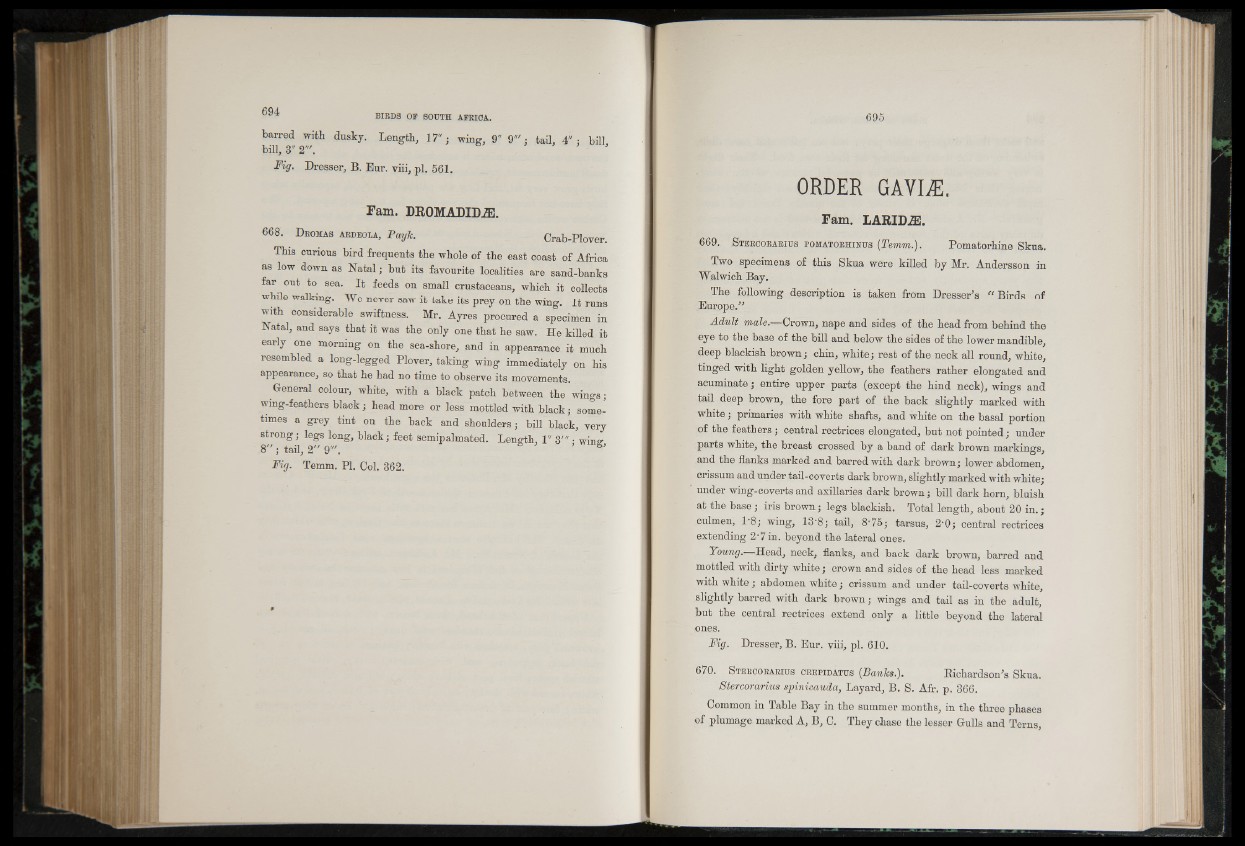
barred with dusky. Length, 17"; wing, 9" 9'"; tail, 4"; bill
bill, 3" 2'". J
Fig. Dresser, B. Eur. viii, pi. 561.
Fam. DROMADIDiE.
668. D romas ardeola, Paylc. Crab-Plover.
This curious bird frequents the whole of the east coast of Africa
as low down as Natal; but its favourite localities are sand-banks
far out to sea. It feeds on small crustaceans, which it collects
while walking. We never saw it take its prey on the wing. It runs
with considerable swiftness. Mr. Ayres procured a specimen in
Natal, and says that it was the only one that he saw. He killed it
early one morning on the sea-shore, and in appearance it much
resembled a long-legged Plover, taking wing immediately on his
appearance, so that he had no time to observe its movements.
General colour, white, with a black patch between the wings;
wmg-feathers black; head more or less mottled with black; sometimes
a grey tint on the back and shoulders; bill black, veiy
strong; legs long, black; feet semipalmated. Length, 1" 3'" • wines
'' ; tail, 2" 9'". ’
Fig. Temm. PI. Col. 362.
ORDER GAVLE.
Fam. LARID2E.
669. S tercorarius pomatorhinus {Temm.). Pomatorhine Skua.
Two specimens of this Skua were killed by Mr. Andersson in
Walwich Bay.
The following description is taken from Dresser's “ Birds of
Europe."
Adult male.—Crown, nape and sides of the head from behind the
eye to the base of the bill and below the sides of the lower mandible,
deep blackish brown; chin, white; rest of the neck all round, white,
tinged with light golden yellow, the feathers rather elongated and
acuminate; entire upper parts (except the hind neck), wings and
tail deep brown, the fore part of the back slightly marked with
white; primaries with white shafts, and white on the basal portion
of the feathers ; central rectrices elongated, but not pointed; under
parts white, the breast crossed by a band of dark brown markings,
and the flanks marked and barred with dark brown; lower abdomen,
crissum and under tail-coverts dark brown, slightly marked with white;
under wing-coverts and axillaries dark brown; bill dark horn, bluish
at the base ; iris brown; legs blackish. Total length, about 20 in.;
culmen, 18; wing, 13’8; tail, 8-75; tarsus, 2-0; central rectrices
extending 2-7 in. beyond the lateral ones.
Young.—Head, neck, flanks, and back dark brown, barred and
mottled with dirty white; crown and sides of the head less marked
with white; abdomen white; crissum and under tail-coverts white,
slightly barred with dark brown; wings and tail as in the adult,
but the central rectrices extend only a little beyond the lateral
ones.
Fig. Dresser, B. Eur. viii, pi. 610.
670. S tercorarius c repidatus {BanJcs.). Richardson's Skua.
Stercorarius spinicauda, Layard, B. S. Afr. p. 366.
Common in Table Bay in the summer months, in the three phases
of plumage marked A, B, C. They chase the lesser Gulls and Terns,